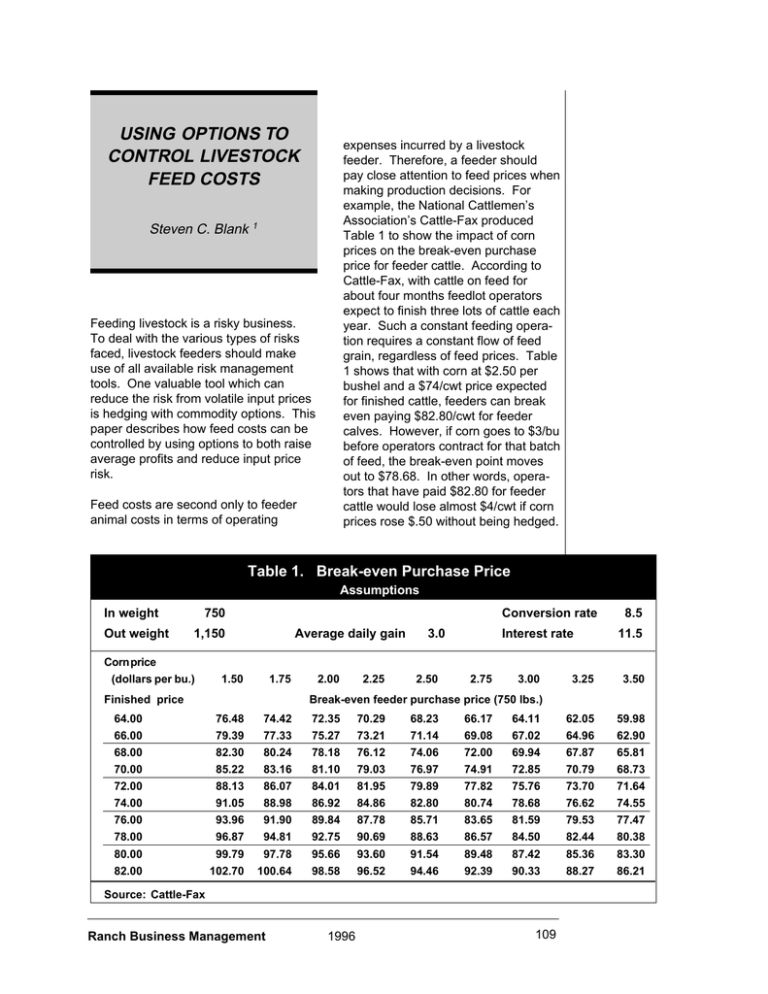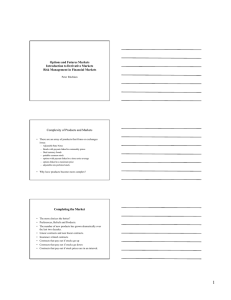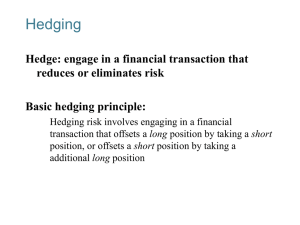USING OPTIONS TO CONTROL LIVESTOCK FEED COSTS Steven C. Blank
advertisement

USING OPTIONS TO CONTROL LIVESTOCK FEED COSTS expenses incurred by a livestock feeder. Therefore, a feeder should pay close attention to feed prices when making production decisions. For example, the National Cattlemen’s Association’s Cattle-Fax produced Table 1 to show the impact of corn prices on the break-even purchase price for feeder cattle. According to Cattle-Fax, with cattle on feed for about four months feedlot operators expect to finish three lots of cattle each year. Such a constant feeding operation requires a constant flow of feed grain, regardless of feed prices. Table 1 shows that with corn at $2.50 per bushel and a $74/cwt price expected for finished cattle, feeders can break even paying $82.80/cwt for feeder calves. However, if corn goes to $3/bu before operators contract for that batch of feed, the break-even point moves out to $78.68. In other words, operators that have paid $82.80 for feeder cattle would lose almost $4/cwt if corn prices rose $.50 without being hedged. Steven C. Blank 1 Feeding livestock is a risky business. To deal with the various types of risks faced, livestock feeders should make use of all available risk management tools. One valuable tool which can reduce the risk from volatile input prices is hedging with commodity options. This paper describes how feed costs can be controlled by using options to both raise average profits and reduce input price risk. Feed costs are second only to feeder animal costs in terms of operating Table 1. Break-even Purchase Price Assumptions In weight Out weight 750 Conversion rate 1,150 Corn price (dollars per bu.) Average daily gain 1.50 1.75 Finished price 64.00 66.00 68.00 70.00 72.00 74.00 76.00 78.00 80.00 82.00 2.00 2.25 3.0 2.50 Interest rate 2.75 3.00 8.5 11.5 3.25 3.50 62.05 64.96 67.87 70.79 73.70 76.62 79.53 82.44 85.36 88.27 59.98 62.90 65.81 68.73 71.64 74.55 77.47 80.38 83.30 86.21 Break-even feeder purchase price (750 lbs.) 76.48 79.39 82.30 85.22 88.13 91.05 93.96 96.87 99.79 102.70 74.42 77.33 80.24 83.16 86.07 88.98 91.90 94.81 97.78 100.64 72.35 75.27 78.18 81.10 84.01 86.92 89.84 92.75 95.66 98.58 70.29 73.21 76.12 79.03 81.95 84.86 87.78 90.69 93.60 96.52 68.23 71.14 74.06 76.97 79.89 82.80 85.71 88.63 91.54 94.46 66.17 69.08 72.00 74.91 77.82 80.74 83.65 86.57 89.48 92.39 64.11 67.02 69.94 72.85 75.76 78.68 81.59 84.50 87.42 90.33 Source: Cattle-Fax Ranch Business Management 1996 109 Producers can “lock in” their feed price using either forward or futures contracts, but that may not be the most profitable course of action. Hedging with options enables cattlemen to lock in feed costs to protect against market price increases, but with flexibility which may allow feeders to pay lower prices if the market price decreases. An example of the weaknesses of forward and futures pricing is presented below, followed by an illustration of how options hedging avoids these weaknesses. Forward and Futures Contract Inflexibility Hedging using either forward cash or futures contracts locks in a feed price, but gives the hedger no flexibility to take advantage of lower market prices which might be available at a later date. Consider the case of a cattleman who thinks that the current price of corn, trading at $2.50/bu, could go up to $3/bu by the time he needs to lay in additional supplies. He could lock in the $2.50 market price using a forward cash contract. This guarantees his feed cost, no matter what feed prices do in the future. However, if prices fell after the forward contract was signed the cattleman would still be obligated to pay the contract price of $2.50. If the cattleman used a futures hedge he would lock in the current $2.50 price, plus or minus any change in basis.1 The hedge would be placed by buying a corn futures contract with a delivery date on or after the date he actually intended to take delivery of cash grain. If he was right and both cash and futures prices go to $3 before 1 “Basis” is simply the difference between futures and local cash prices for the same product. Even though the two prices will move in the same direction over time, they will not always move in the same amounts, thus basis will change. Ranch Business Management the hedge is liquidated, he would have a $.50/bu profit on his futures position to compensate for the higher cash price which is paid; the net price paid is still the $2.50 his hedge locked in ($3 - .50 = $2.50). He would capture the futures profit by liquidating the futures position by making an equal and opposite transaction in the futures market. In this case it would be to sell a futures contract identical to the one he purchased when placing the hedge. The hedge would be closed on about the same day the cash feed price is set. If the cattleman was wrong and prices fell after the hedge was placed the net price does not change (assuming no basis change). If cash and futures prices fell to $2/bu the hedger would be able to buy cash corn for $2, but he would have a $.50/bu loss on his futures position which raises the total cost of the hedged corn to the price locked in: $2.50 (= $2 + .50). In this situation, the inflexibility of the futures hedge and forward contract led to a higher net price than would have been paid by the cattleman if he had hedged using options. Options Hedging If the same cattleman had placed a hedge using options, he would have benefitted from any price decreases which occurred while the hedge was in place, yet he would have received the same protection against price increases as that provided by futures hedging. The simplest option strategy would be to buy a call option on corn prices. A “call option” gives the option buyer the right, but not the obligation, to buy the commodity at a specified exercise price any time before the option expires. An example of hedging with calls follows. If the cattleman believes that the current corn market price of $2.50/bu could rise, he could hedge by buying a call option with an exercise price of $2.50. For that option the hedger will have to pay a premium of, say $.10 in 1996 110 this case.2 If market prices never change during the time period in which the option can be exercised the hedger would not “exercise his option”, thus it would expire worthless just like other insurance policies. However, if corn price increase during the option’s life, the hedger would exercise the call. For example, if market prices rise to $3/bu the hedger would profit by $.50. Exercising the call in this case enables the hedger to purchase a corn futures contract at the exercise price of $2.50/bu, and he could instantly sell it in the futures 2 market at the going market price of $3, netting the difference as a profit to compensate for the rise in cash corn prices paid. The net price paid for corn would be $2.60: $3 (from the cash market) minus the $.50 options profit, plus the $.10 premium paid to get the option, or the $2.50 he intended to lock in with the hedge plus the option premium paid. The “premium” is the amount paid by an option buyer to get the option. This amount is determined by market and can go up or down over the short run. As the option approaches its expiration date, the premium will decrease because part of its value is determined by the amount of “time” before it expires; the more “time” before an option expires, the more “time value” it has in its premium. At the date an option expires it obviously has no “time” left, so its time value decreases to zero. At that point, an option’s premium will equal its “intrinsic value”, which is the value of the option if it were exercised at that point in time. A call option will have intrinsic value only if the current market price is above the option’s exercise price. If an option has no intrinsic value, it will be worthless at the time it expires. If it does have some intrinsic value, the option buyer will exercise the option to capture the intrinsic value at that time. If corn prices fell during the life of an option, the flexibility of options hedging becomes clear. Options give the buyer the right, but not the obligation, to make a transaction at the exercise price. For a cattleman using calls to hedge against feed price increases, no options would be exercised in a falling price market. If corn prices fell to $2/bu, for example, the hedger would pay $2 for cash corn plus the premium, $.10 in this case. Thus, the cattleman would pay $.40/bu less for his feed if he hedged using options rather than forward cash or futures contracts in this falling price market. To gain this potential benefit, the hedger did have to pay an extra cost, the option’s premium. However, in volatile markets, such as this example, the cost proved to be a good investment. Extension Economist 1 Agricultural Economics Department University of California Davis, California Ranch Business Management 1996 111 FROM: California Ranchers' Management Guide Steven Blank and James Oltjen, Editors. California Cooperative Extension Disclaimer Commercial companies are mentioned in this publication solely for the purpose of providing specific information. Mention of a company does not constitute a guarantee or warranty of its products or an endorsement over products of other companies not mentioned. The University of California Cooperative Extension in compliance with the Civil Rights Act of 1964. Title IX of the Education Amendments of 1972, and the Rehabilitation Act of 1973 does not discriminate on the basis of race, creed, religion, color, national origins, or mental or physical handicaps in any of its programs or activities, or wish respect to any of its employment practices or procedures. The University of California does not discriminate on the basis of age, ancestry, sexual orientation, marital status, citizenship, medical condition (as defined in section 12926 of the California Government Code) or because the individuals are disabled or Vietnam era veterans. Inquires regarding this policy may be directed to the Personnel Studies and Affirmative Action Manager, Agriculture and Natural Resources, 2120 University Avenue, University of California, Berkeley, California 94720, (510) 644-4270. University of California and the United States Department of Agriculture cooperating. Ranch Business Management 1996 112






